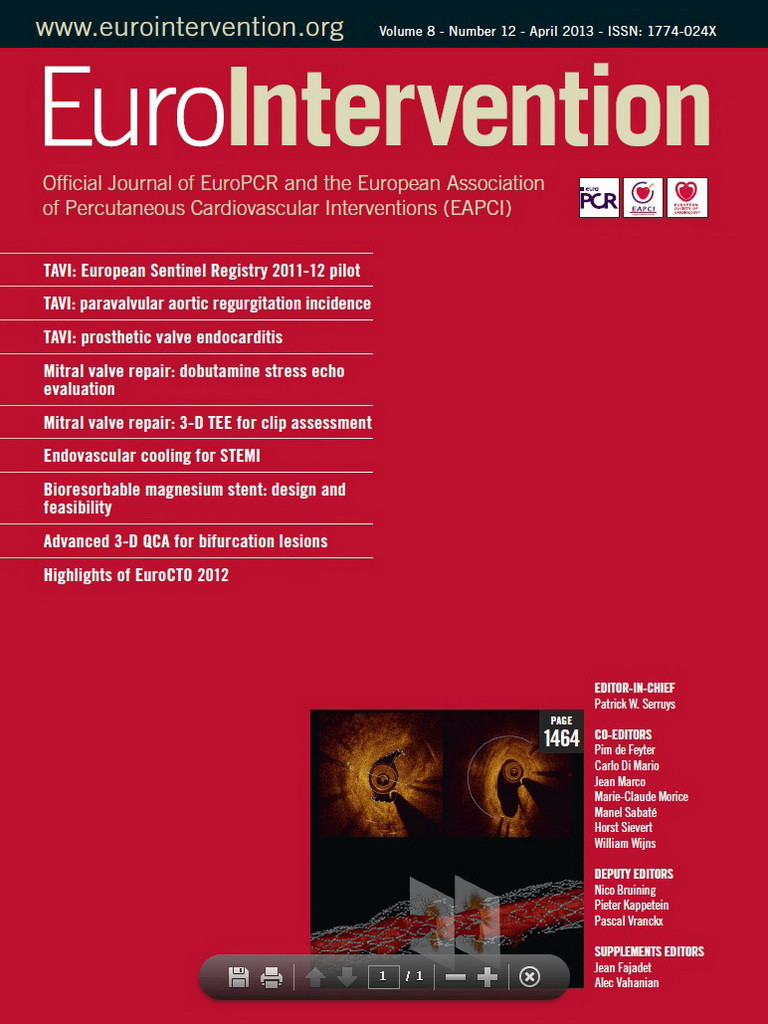Transcatheter aortic valve implantation (TAVI) is a technology introduced to care for a population of patients with symptomatic severe aortic stenosis who were either not receiving care or receiving aortic valve replacement albeit at a high risk. Although this technology potentially provided life-saving treatment, it was both expensive and itself came at substantial risk. Europe has been a leader in TAVI and recently the United States and Canada have joined with completion of the randomised Placement of Aortic Transcatheter Valves (PARTNER) Trials in non-operative and high-risk patients for surgical aortic valve replacement1,2. These studies, coupled with prospectively enrolled European national registries, have arguably provided more supporting clinical evidence for commercialisation than any other previous heart valve –certainly no surgical device has been subjected to this level of scrutiny in randomised study.
In this issue of EuroIntervention, De Mario and colleagues report the initial results of the 2011-2012 pilot European Sentinel Registry of Transcatheter Valve Implantation3. This report is a by-product of the EURObservation Research Programme (EORP) of the European Society of Cardiology (ESC), and represents the refinement of the national registries from 137 centres in 10 European Countries. A multi-disciplinary team that included cardiac surgeons, interventional cardiologists, intensive care physicians, and cardiovascular imaging specialists prospectively created the data elements for the Sentinel Registry. Definitions for baseline demographics were standardised and endpoints were defined using VARC criteria4. A similar post-market effort has been initiated with the Transcatheter Valve Therapy (TVT) Registry by the American College of Cardiology and Society for Thoracic Surgery5.
The Sentinel Registry provides essential information about contemporary patient selection and procedural outcomes of TAVI, and currently includes both the Edwards SAPIEN (Edwards Lifesciences, Irvine, CA, USA) and Medtronic CoreValve (Medtronic, Minneapolis, MN, USA) devices. Consistent with the high-risk selection criteria, younger (<80 years) patients in the Registry had more co-morbidities than older patients, albeit with lower EuroSCOREs. There was substantial regional variation in risk profiles of patients enrolled in the Registry, and regional differences were also noted in hospital length of stay, access utilised, and use of general anaesthesia. Importantly, procedure success was high (96.5%), and in-hospital mortality (7.4%) and stroke (1.8%) were acceptable for these high-risk patients. Both the CoreValve and the transfemoral SAPIEN devices had similar mortality rates.
Despite the incredible incremental value of this report, there are some potential limitations to the sole use of post-market registries such as the Sentinel Registry for monitoring outcomes after TAVI. Stroke rates were lower (1.8%) than reported in randomised studies (3.8-5%) that included prospective surveillance and rigorous neurologic testing before and after the procedure6,7. Addition of the National Institutes of Health Stroke Scale and modified Rankin scores before and after the procedure may be a useful addition to the Registry. Site-reported moderate (6.1%) or severe (0.6%) post-implantation aortic regurgitation was present after use of the SAPIEN device in the Sentinel Registry, whereas 30-day moderate to severe post-procedural aortic regurgitation was present much more frequently (12-15%) when reported by a central core laboratory in the randomised SAPIEN studies6,7. These differences are likely to relate to the criteria with which regurgitation was assessed, and accordingly, device-device comparisons should be limited in the absence of randomised studies or core laboratory readings. Finally, randomised studies are still required for the assessment of surgical and transcatheter AVR outcomes in patients at intermediate risk (STS predicted risk of mortality 4-10%), and the PARTNER II, Cohort A and SurTAVI require the support of both European and North American cardiac surgeons and interventionists.
We anticipate that the 2011-12 pilot Sentinel TAVI Registry will be the first of many reports from this collaborative group that will become more refined with age and experience. Future iterations may include longer-term outcomes (30 day and/or one year) and the addition of newer TAVI devices. In the interim, it is reassuring to know that the expansion of TAVI has been performed in a safe and responsible fashion, at least in part attribute to the surveillance of the EURObservation Research Programme (EORP) of the European Society of Cardiology (ESC) and the efforts of these investigators.
Conflict of interest statement
J. J. Popma reports receiving consulting fees from Abbott Vascular, Boston Scientific, and Covidien and grant support from Abbott Vascular, Abiomed, Boston Scientific, Cordis, and Medtronic and is a principal investigator for the CoreValve® US Pivotal Trial and the SurTAVI trial. M. J. Reardon is a consultant for Medtronic and is a principal investigator for the CoreValve® US Pivotal Trial and the SurTAVI trial.

